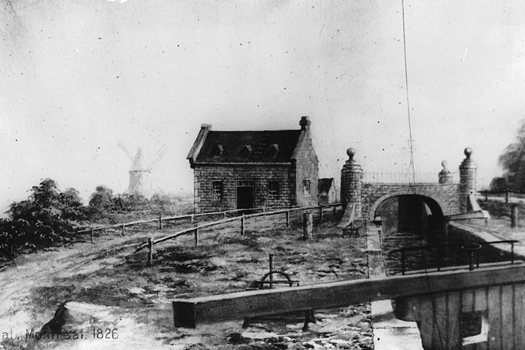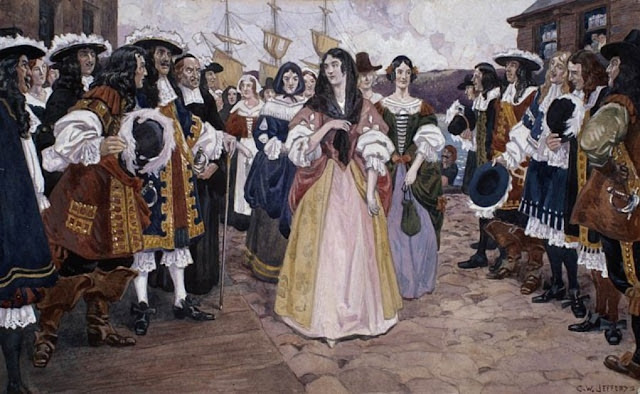The Filles Du Roi: How Historical Revisionists And Feminists Have Slandered My Ancestors
 |
| French Canadian settlers in Lachine |
What is fact cannot be changed
Respected historians have studied the Filles du Roi in earnest. They appear to have combed through every scrap, every log and church record, and all government archives. Taken all together, their works comprise an astounding body of data about the 800 courageous women sent to Canada by the king of France in the 17th century in an effort to boost the colony’s population.
I’m not a researcher. I rely entirely on the published works of Canadians Gustave Lanctôt, Yves Landry, Peter Gagné, Marcel Trudel, and many others who collectively devoted years researching and gathering so many onerous details. Their written works differ mildly in places, but never enough to distort the basic truths.
Unfortunately there are also non-historians attempting to change the story, to revise empirical findings that are well established. But why would anyone want to do this, you ask? Probably because we live in an age where some people want to further their personal and sometimes misguided political beliefs. Re-interpreting a historic event is one way, by taking licence to rewrite it according to their own biases — even though these events took place more than 300 years ago and they couldn’t possibly know something that respectable researchers just happened to overlook.
Myth #1: Glamorous Arrivals
Since photography didn’t exist in the 1600s, artists hundreds of years later have taken great liberties. Paintings that have now become defining images for the Filles du Roi are apparently not based on facts at all.
In my view, the following work illustrates a vivid imagination about French royalty, but certainly not about life in early Québec. Even a minor study of the lives of settlers and soldiers establishes how completely unlikely it was that the ornate clothing depicted in this now-famous scene hung in the closets of their small, impoverished dwellings, or in the case of the arriving Filles du Roi, survived a long and challenging Transatlantic crossing. Left and right shoes didn’t even exist until two more centuries would pass.
Portraying the Filles disembarking their ships in such grand style is absurd. When they reached Canada, their passages had taken great tolls. Many had died at sea — more than 60 from all voyages. Not only had the surviving Filles not bathed since departing France months earlier, they were malnourished, they were sickly and disoriented. They had spent months below decks with livestock and rodents. It was all they could do to stand on solid ground.
Nothing I found in established data states that arrivals were glamorous events. Yet Jefferys’ painting has become iconic, appearing in texts everywhere and throughout academia, giving the story a visual element that belies the truth. People believe it and teach others. Now authors write about it as though it happened according to Jefferys’ colourful fantasy.
Another painting, the work of Eleanor Fortescue-Brickdale and created more than 260 years after the last envoy of arriving Filles du Roi, has also become symbolic of their entrance after a treacherous North Atlantic crossing.
Considering that the majority of the women were abjectly poor and would not have afforded the regal garments portrayed in this ubiquitous work, it should never have been so widely accepted as the truth. Not only do I regard the premise as whimsical, I also question the artist’s depiction of … wait a minute. Is that a slave in the foreground? Slavery wasn’t even introduced to New France until more than a decade after the last Filles landed, and even then, it was highly obscure. Why then is this painting placed in history books where it supports the lie that our ancestors were misogynistic, evil slave owners?
Try to imagine how these works might give fuel to social justice warriors in today’s world. Arrivals of Filles du Roi were already documented without pomp and splendour or shows of subservience, yet we are hoodwinked into embracing a flawed version of history, not one unearthed by research, but one that has been fictionalized by self-appointed storytellers.
There is no excuse. We’ve always known the truth.
Validated data of the best historians state that chaperones took the enfeebled women directly to convents of the Ursuline Sisters where they could recover from their journeys. Only after weeks of convalescence were they able to interview prospective husbands — without obligation to choose at all. The nuns counselled them strongly on making sound decisions, not to rush, and to avoid suitors who demonstrated little security. The arrivals were insignificant events compared to the hardship, the will to survive, and the glue of strong families that later became the crux of their success in their roles as founding mothers of Québec and ultimately of an entire nation.
 |
| Canadian artist Charles Vinh understood just how much we crave an enchanting story with this lovely 21st century depiction of the arrival of the Filles du Roi. |
It’s nice to think that we descended from beautiful and refined young women who emerged from their ships refreshed and attired as Vinh imagined. Likewise for the dashing young men who were supposedly on hand for a respectable meet-and-greet. But that is absolutely not what happened.
Most if not all Filles emerged from their ships disoriented and ill. On their voyages, sometimes lasting three months, they had shared quarters with livestock. None had properly bathed since leaving France. All were malnourished and living with prolonged effects of scurvy, some close to death when their ships finally made landfall.
How they really landed
The Filles du Roi were actually met by the Ursuline nuns or by their chaperones. The nuns nursed them back to health before any meetings were arranged, where the women were eventually urged to choose mates with great caution. Despite all unreliable portrayals of their arrivals, this fairly unsung work is probably the most accurate. Titled “Arrival of the Filles du Roi at the Maison Saint-Gabriel” by David Mackie, it depicts Sister Bourgeoys meeting some Filles upon their landing.
 |
| Arrival of the Filles du Roi at the Maison Saint-Gabriel |
Myth #2: Forced Motherhood
Descendants should also question the feminist position that has materialized out of thin air that the women were forced onto ships out of destitution and hauled over to New France to procreate against their wishes.
While the possibility exists that a modern interpretation of mysogeny prevailed in the 17th century, it would be a social condition known to practically every world nation, not just to the French. Moreover, there is no proof that it was so. And if the Middle Ages supported a cruel disparity between genders, who can argue that it was objectionable in a world that knew no other way?
A modern-day assertion of olden-day evil continues to discolour a past that cannot be modified. Feminists today who declare that Filles had no choice but to submit to men who used them as unwilling child-bearers or as domestic slaves must at least be fans of good fiction. But nothing of this recent caprice was ever mentioned in over 300 years. Hundreds of our Filles ancestors for whom we have data appear to have had normal, monogamous, usually lifetime marriages that lasted until divine intervention — and undoubtedly there were philanderers as there are today.
Demographers have a vastly different opinion on the topic. Back in France women seldom had a choice in whom they married. They often accepted the fate of arranged marriages because fathers wanted assurance about the men who would ultimately assume their property. Older daughters usually received a family dowry, thus assuring they would marry into a better class, but any remaining daughters unfortunately had little or no dowry.
When prospective Filles were recommended by their parishes and recruited, say historians, they saw their participation in the program as an immense opportunity. Landry stated that 57% had lost their fathers and any possibility of a dowry. So beyond all uncertainties that came with departing France, not only did the Filles acquire a royal dowry, but with an abundance of potential husbands, they could be selective in a way that their counterparts back in France could not. They would also have complete jurisdiction to refuse marriage altogether if they so chose, although few relished the stigma of spinsterhood with a burgeoning supply of willing men around. (The ratio of men to women was about 6 to 1.)
Before the mid-20th century, marriage was a rite of passage. And it was expected of practically everybody. Of course there were always a few women or men who didn’t marry, but that was rare. Therefore nobody can deny that the Filles du Roi arrived with a sincere desire to marry and have children. They were normal women, fulfilling roles entrenched in their culture, roles dictated by society and by their Catholic faith.
The legal system in Québec made provision for marital anulments, and court records confirm that such anulments were granted surprisingly often. The literature makes it clear that if a husband were so intolerable for any of the Filles du Roi, then leaving him was always an option, even if it was difficult. As the archives from early Québec have shown us, that option was certainly exercised. It’s not often cited by today’s feminists, however, who love blaming French males for horrible, albeit previously unheard of cruelty.
Myth #3: Society’s rejects and prostitutes
The most common myth about the Filles du Roi is that they were harvested from France’s lowest society or they were prostitutes. This malignant slander was begun by the French nobleman Baron de Lahontan who travelled to Québec as a soldier in 1683, and upon his return he smugly wrote a travelogue denigrating not only the Filles du Roi but the entire colony. Since only France’s elite was educated and could read, his intended audience was obvious.
For more than three centuries his writings propagated the world and were taken as fact without any basis. Modern historians such as Lanctôt and Landry saw the folly in his words because they completely disregarded legitimate church and government records paintstakingly kept by authorities of the day. Naturally the erroneous but spicier version was already well established, and it continues to permeate the legend with an indelible stain.
Today experts cite Lahontan as a blatant liar. And they have amassed an abundance of evidence to prove it.
I noticed that Lahontan only arrived in New France a full decade after the last Filles had landed and settled. I doubt that this important fact was missed, but I state it anyway: He had absolutely no way of knowing anything about their recruitment in the old country some 20 years prior as women of “middling virtue”, to use his term. Lahontan’s embellishments might easily prove that even 300 years ago the media could be creative for financial, political, or social gain.
Among so many other records that debunk the myth, the Directory of Québec’s Cultural Heritage states (in French) that:
Due to their modest origins, the King’s Daughters have often been wrongly represented as women of bad life. The most recent research shows that girls chosen to be sent to New France were selected according to fairly strict criteria, even requiring certificates of good conduct testifying to their morality since they were not to take advantage of the king’s royal generosities.
Clearly since many Filles were girls who had lost one or both parents, they had no recourse but to seek refuge in orphanages. Even living parents who were financially bereft appear to have encouraged their daughters for the opportunity of better lives. And among the 768 women were a few who came from the upper bourgeoisie and nobility. They were all interviewed by the king’s representatives for suitability. Only those believed to be virtuous and strong enough to survive the demands of life in the new frontier were accepted.
But perhaps the best evidence arose back in 1702 from the Ursuline sister, Marie-Andrée Duplessis when she wrote in dissent to Lahontan:
It must not be believed that the girls sent from France to marry in Canada were of poor morals. Most of them were ladies of quality without means; others were from good families with too many children. They sent them to this country in the hope that they would be provided for.
The consensus is that over three centuries of historical research there has never been a shred of evidence that the Filles du Roi were prostitutes. Please beware of fact-changers, even today.
Myth #4: Invaders
And finally, Canadians should also be clear on this point: Not a single person arriving in Québec in the 17th century was an “immigrant”. Immigrants move to an existing country, one with an infrastructure and boundaries. Our Québec ancestors, both women and men, were legitimate settlers. Settlers move to an untamed wilderness whose dominion has yet to be recognized. Those poor French colonists carved out a meagre existence in harsh conditions and died there for the future of their descendants — that would be us. We cannot allow today’s progressivists tell us that we are all immigrants to this country. No more should we listen when they say that our French forefathers stole the land from aboriginals. Those claims are simply not true as borne out by facts and conveniently ignored by universities bent on postnationalist ideologies. As Tim Murray, contributing journalist to the Council of European Canadians, put it:
[There is no] moral authority to accuse so-called “white settlers” of being thieves and interlopers. Our ancestors worked their guts out from dawn to dusk to clear the land and eventually grow enough food to feed tens of millions of people at home and abroad. They earned their “white privilege” by hard work. They also brought literacy, advanced technology, electricity, and modern medicine to the table.
It’s reasonable that no apologies are necessary for the net contributions of our ancestors for giving us everything we enjoy today. The politically correct narrative, however, is fairly disgraceful. While society is now replete with those who have learned to cite Europeans as racists and assert White guilt on their fellow citizens, there is an interesting observation by Taki journalist Jim Goad that would apply directly to our Québécois ancestors:
Whites who are likely to have descended from slave owners are blaming the Whites [for racism] who are likely to have descended from indentured servants.
Read the official censuses of the 1660s and 1670s, and you will see that by far most families of the Filles du Roi were themselves indentured servants in Canada, working as engagés (domestic servants) of land owners. This, I found, applied to nearly every one of my own 18 Filles ancestors. How dare anyone assert that we enslaved others!
The culture of hard work and humility among Québec’s poor settlers in the 17th and 18th centuries was still completely visible in my grandparents’ generation as recently as the 20th century. Likewise, when today’s feminists insist that the Filles were subservient, disrespected, or abused by men, I only need to look at the respect for females over the past three or more generations in my own family to know what was almost certainly the same reputable behaviour handed down by three more generations that preceded them, and they include those brave Filles.
While most millennials have never heard of the Filles du Roi and baby-boomers might only remember scant details from school texts, there is so much more that deserves to be said about how these splendid women and the husbands they chose contributed to Canada’s birth. Sadly, only people from the newest slices of time are attacking the story of the Filles without any effort to study the actual data. It’s a fine thanks.
Finally, I make the point that millions of people alive today descended from the Filles du Roi and their French-born husbands. Jean Chretien, Madonna, Hillary Clinton, Celine Dion, and Angelina Jolie are among the notable. Ironically, Justin Trudeau is NOT a descendant [1] of the Filles du Roi, although he does have a rich Québécois heritage that entirely contradicts his brash sentiments.
Footnotes
[1] Trudeau’s family line is only laterally related to the Filles du Roi through marriages that occurred in later years. Unlike true descendants, his family has no direct maternal or grandparental connection to any of the 768 academically recognized Filles.






